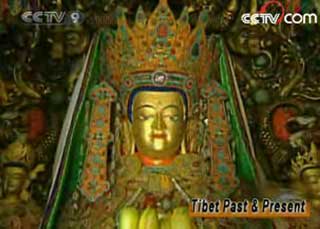------Program code: DO-080504-04039 (what's this?)
Source: CCTV.com
05-04-2008 14:55
Tibetan Buddhism
This is an average Tibetan Buddhist temple. Monks start a new day chanting. Buddhism was introduced to Tibet from Chinese inland, India and Nepal. Tibet Buddhism is a combination of original Buddhism and local religions. It is a religion with strong ethnic characteristics, a vast amount of scriptures and a special reincarnation system of living Buddha, or Tulkus.
 |
| Watch Video: Part 2 |
In the mid-7th century CE, the Tibetan King, Songzain Gambo, married princesses from China's Tang Dynasty and Nepal. They brought two sculptures of the young Sakyamuni and many Buddhist scriptures to Tibet. Influenced by his wives, King Songzain Gambo believed in Buddhism and built the Johkang Temple and Ramoche Temple.
In the late 10th century, Tibetan Buddhism became a formal religion. It became popular in Mongolian area in the 13th century. In the next 3 hundred years, many influential groups were formed within the religion, including Nyingmapa, Kagyupa, Sakyapa and Gelugpa. The Panchan Lama and the Dalai Lama are two most important living Buddhas of the Gelugpa.
The original Tibetan religion, Bon, adopted many Buddhist thinkings and practices and is widely considered as a group within Tibetan Buddhism.
 |
The development of Buddhism in Tibet is divided into two periods. Tibetan historical documents call them "Snga dar" and "Phyi dar". The period from the mid 7th century to mid 9th century is called "Snga dar" or "Earlier dissemination", the "Phyi dar" or "Later dissemination", starts from the tenth century. Tibetan Buddhism came into being during the "Phyi dar". Tibetan Buddhism has an abundance of texts. The Tibetan Tripitaka is divided into two parts: the "Kangyur" and the "Tengur". "Kangyur" are mainly original Buddhist classics, while "Tengyur" are the explanation and discussion of the "sayings of Buddha" by the disciples of Sakyamuni.
There are big and small temples of Tibetan Buddhism. Small temples might have only several monks, while large ones can have 7,000 to 8,000. A monastery usually includes chanting halls, a holy palace, halls for debating Buddhist Scriptures, Buddhist scripture houses, sleeping quarters for monks, offices, a storehouse, guest rooms. Historically, monasteries have the center of religion, culture, the economy and politics for a certain area in Tibet.
Most Tibetans believe in Tibetan Buddhism. In the past, if a family had more than one son, at least one had to become a monk. If there were two sons in a family, one would become a monk. If there were three sons, two would become monks. In the 1500s, a quarter of Tibet's population were monks. In 1951, there were about 120,000 monks in Tibet -- one tenth of the Tibetan population. Traveling today in Tibet, monasteries and temples have been rebuilt and can be seen everywhere, with robed monks in the streets.
